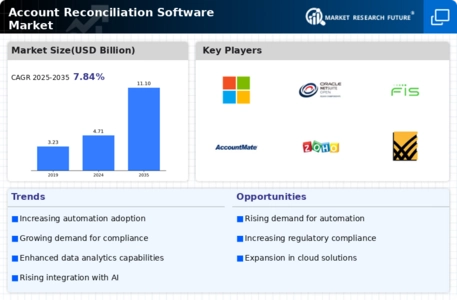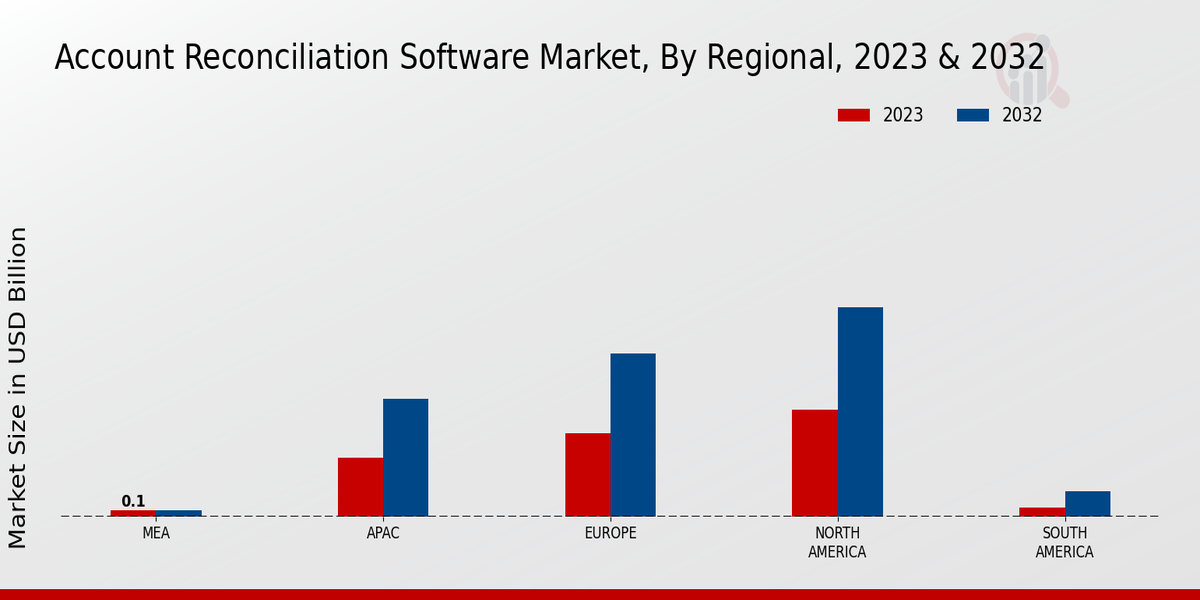Market Growth Projections
The Global Account Reconciliation Software Market Industry is poised for substantial growth, with projections indicating a market size of 4.71 USD Billion in 2024 and an anticipated increase to 11.1 USD Billion by 2035. This growth trajectory reflects a compound annual growth rate of 8.14% from 2025 to 2035. Factors contributing to this expansion include the increasing demand for automation, regulatory compliance, and the rising complexity of financial transactions. As organizations continue to prioritize efficient financial management, the reconciliation software market is likely to thrive, driven by technological advancements and a focus on transparency.
Increasing Demand for Automation
The Global Account Reconciliation Software Market Industry experiences a surge in demand for automation solutions. Businesses are increasingly seeking to streamline their financial processes, reduce manual errors, and enhance efficiency. Automation not only accelerates reconciliation processes but also provides real-time insights into financial data. As organizations recognize the potential for cost savings and improved accuracy, the adoption of automated reconciliation software is likely to rise. This trend is reflected in the projected market growth, with the industry expected to reach 4.71 USD Billion in 2024, indicating a robust shift towards automated financial management.
Regulatory Compliance Requirements
Regulatory compliance remains a critical driver for the Global Account Reconciliation Software Market Industry. Organizations are compelled to adhere to stringent financial regulations and reporting standards, which necessitate accurate and timely reconciliations. The increasing complexity of compliance requirements across various jurisdictions drives the demand for sophisticated reconciliation solutions. Companies are investing in software that not only simplifies compliance processes but also provides audit trails and documentation capabilities. This focus on compliance is anticipated to contribute significantly to the market's growth trajectory, as businesses prioritize tools that ensure adherence to evolving regulations.
Growing Focus on Financial Transparency
Financial transparency is becoming a paramount concern for organizations, significantly impacting the Global Account Reconciliation Software Market Industry. Stakeholders, including investors and regulatory bodies, demand greater visibility into financial operations. This emphasis on transparency compels companies to adopt reconciliation software that provides detailed insights into financial data and processes. By enhancing transparency, organizations can build trust with stakeholders and mitigate risks associated with financial mismanagement. As businesses increasingly recognize the value of transparent financial practices, the demand for reconciliation software is likely to grow, further propelling the market forward.
Rising Complexity of Financial Transactions
The Global Account Reconciliation Software Market Industry is influenced by the rising complexity of financial transactions. As businesses expand globally, they encounter diverse currencies, payment methods, and financial instruments, complicating reconciliation efforts. This complexity necessitates advanced software solutions capable of handling multifaceted transactions efficiently. Companies are increasingly adopting reconciliation software that integrates with various financial systems, enabling seamless data synchronization and reducing discrepancies. The demand for such solutions is expected to drive market growth, with projections indicating a market size of 11.1 USD Billion by 2035, reflecting the need for sophisticated reconciliation tools in a dynamic financial landscape.
Technological Advancements in Software Solutions
Technological advancements play a pivotal role in shaping the Global Account Reconciliation Software Market Industry. Innovations such as artificial intelligence, machine learning, and cloud computing are transforming the capabilities of reconciliation software. These technologies enable enhanced data analysis, predictive insights, and improved user experiences. As organizations seek to leverage these advancements for better financial management, the adoption of cutting-edge reconciliation solutions is expected to rise. The anticipated compound annual growth rate of 8.14% from 2025 to 2035 underscores the potential for growth driven by technological innovation in the reconciliation software sector.

























